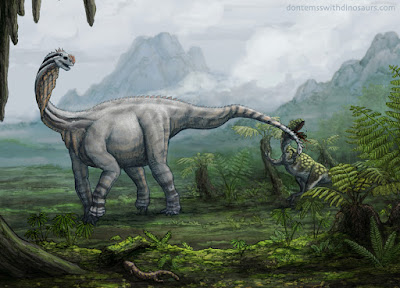Type Species: Tianyulong confuciusi
Classification: Dinosauria - Ornithischia - Heterodontosauridae
Time Period: Late Jurassic
Location: China
Diet: Herbivore
Tianyulong was a Late Jurassic heterodontosaur that lived during the Oxfordian stage of China. Its remains were discovered in the Tiaojishan Formation of China. During prehistoric times, this mountainous landscape was overshadowed by brooding volcanoes that had a penchant for erupting; the area was cut by mountain streams and deep sapphire lakes choked by dense gymnosperm forests. The jungle-like forest consisted of ginkgoes and conifers, lycopsids and horsetails, cycads and ferns. Many creatures called this place home: small feathered dinosaurs, numerous pterosaurs, salamanders and insects and arachnids. There were early mammals – including the earliest gliding mammal Volaticotherium and an aquatic protomammals Castorocauda. Tianyulong skittered among the jungle-choked ravines and waterways of this prehistoric Chinese environment. It was descended from the earlier heterodontosaurs of the Early Jurassic, and though it had classic heterodontosaur characteristics – in particular its mixed collection of teeth and large tusks at the front of the mouth – it had evolved distinct differences. Its head was large, and its legs and tail were long, but its neck and forelimbs were unusually short. Tianyulong’s diverse array of teeth indicate that it was capable of eating meat, but it was likely herbivorous; nevertheless, the possibility of an omnivorous diet remains.
Tianyulong had a row of long, filamentous integumentary structures on its back, tail, and neck. The similarity of these structures with those found on some theropods suggests their homology with feathers and raises the possibility that the earliest dinosaurs and their ancestors were covered with homologous dermal filamentous structures that can be considered primitive feathers (often called ‘proto-feathers’). The hollow filaments are parallel to each other and are singular with no evidence of branching. They also appear to be relatively rigid, making them more analogous to the integumentary structures found on the tail of Psittacosaurus than to the proto-feather structures found in avian and non-avian theropods. Among the theropods, the structures in Tianyulong are most similar to the singular unbranched proto-feathers of Sinosauropteryx and Beipiaosaurus. Because such structures had previously only been seen in derived theropods and ornithischians, their discovery in Tianyulong puts the existence of such structures further down the phylogenetic tree (as heterodontosaurs were rather ‘primitive’ ornithischians). The presence of these structures on Tianyulong is thus explained in one of two ways: either the common ancestor of both saurischians and ornithischians were covered by feather-like structures, and some branches of the dinosaurian lineage ‘lost’ them to become ‘secondarily featherless;’ or these structures evolved independently in saurischians and ornithischians, as well as in other archosaurs such as the pterosaurs. The precise ‘genesis’ of proto-feathers is hotly debated and there remains no consensus.



.JPG)


.jpg)





















